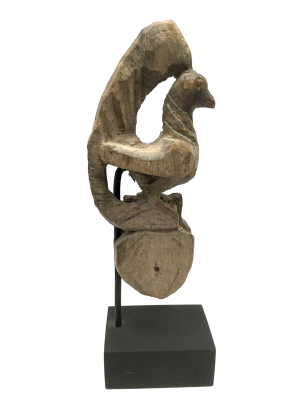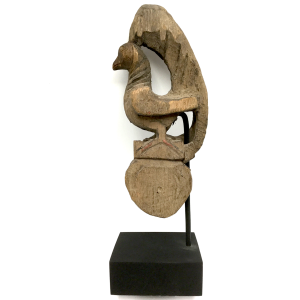-
Sale!


$365.00 Original price was: $365.00.$325.00Current price is: $325.00.
H: 13″ W: 8.5″ D: 4.75″ | CALL 213-568-3030 OR EMAIL [email protected] FOR SHIPPING.
Hindus use oil lamps (diya) like for ritual prayer rituals (puja) performed on home altars. Light and the act of lighting a lamp signify purity, virtuosity, goodness and brings one good luck and power. Peacocks are common motifs symbolize love, joy, peace and harmony.
-
Sale!


$245.00 Original price was: $245.00.$150.00Current price is: $150.00.
H: 13” W: 3.75” D: 2.625” | FREE SHIPPING WITHIN CONTINENTAL U.S.
This Burmese teak heddle pulley is topped by a graceful peacock. The peacock symbolizes wholeness, combining all colors with its spread tail and the fleeting nature of all sentient beings. Drawing on old animistic beliefs, old folk art Burmese heddles are decorated with carvings of mythical or auspicious animals providing the weaver protection and assuring good quality weaving. Mounted on wood base.
-
Sale!


$245.00 Original price was: $245.00.$150.00Current price is: $150.00.
H: 14″ W: 2.675” D: 3.5” | FREE SHIPPING WITHIN CONTINENTAL U.S.!
This elegant heddle pulley carved from a single piece of Burmese teak is topped by a peacock, which in Buddhism represents the short-lived nature of all things. Borrowing from ancient animistic traditions, it was believed that auspicious symbolic animal images protected the weaver, assured quality weaving, and pleased the gods and spirits. This antique folk piece is wonderfully weathered from time and use.
-
Sale!


$265.00 Original price was: $265.00.$165.00Current price is: $165.00.
Ht: 10.625″ W: 3.375″ D: 2.5″|FREE SHIPPING WITHIN CONTINENTAL U.S. !
This elegant antique heddle-pulley carved from a single piece of Burmese teak is topped by a hamsa, a goose-like bird and a sacred Buddhist symbol of wisdom. Auspicious symbolic animal images are believed protect the weaver, assure quality weaving, and pleases the gods and spirits. It is wonderfully weathered from time and use with minor losses with a fine patina. Mounted on a black wood base, this heddle pulley pairs well with item number 11298A.
-
Sale!

$395.00 Original price was: $395.00.$325.00Current price is: $325.00.
H: 16″ W: 13 ” D: 1″ | CALL 213-568-3030 OR EMAIL [email protected] FOR SHIPPING
This glass painting of a peacock was one of a pair of panels inset in an antique Indian cabinet along with Krishna Playing his Flute (3982). Beautifully painted with reflective silver accents it is a vibrant and remarkable wall hanging. As both panels were originally displayed together, we recommend they be kept as a pair.
-
Sale!


$495.00 Original price was: $495.00.$395.00Current price is: $395.00.
H: 30″ W: 29.5″ D: 2.125″ | CALL 213-568-3030 OR EMAIL [email protected] FOR SHIPPING.
This vintage beadwork tapestry displays many auspicious Hindu symbols: the Tree of Life, the Monkey God Hanuman, a horse and a pair of peacocks together symbolizing the cycle of life, spiritual growth, enlightenment, divine wisdom and beauty. Traditionally placed at home doorways and thresholds they symbolize warmth, positivity, and protection and invite good luck and blessings to the home and are used in many Indian celebrations.
End of content
End of content











